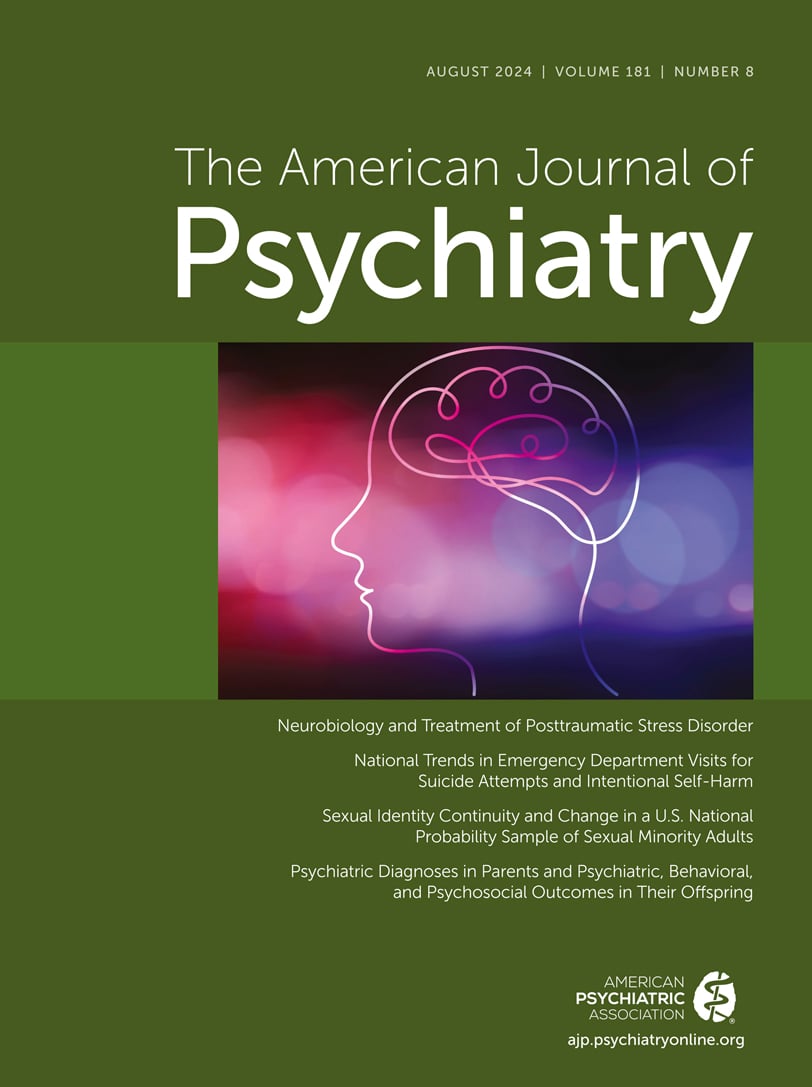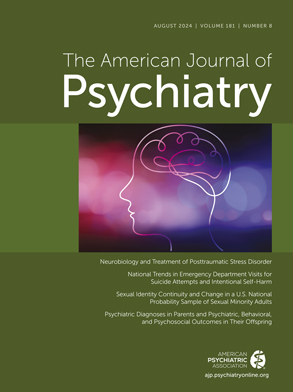Suicide attempt is an outcome of a personal crisis and deep distress. Many individuals with a suicide attempt may have mental health disorders, but this is not a contributing factor for all cases. Although related, suicide attempts differ from self-harm by being acts conducted with suicidal intent (
1). Also, a larger proportion of self-harm incidents are seemingly due to cutting, while poisonings account for a larger share of suicide attempts.
The World Health Organization recommends monitoring of suicide attempts as an integral part of national strategies for suicide prevention (
2). Having national figures on suicide attempt enables researchers to keep track of trends. However, being able to quantify the burden related to suicide attempts may also motivate policy makers to address this emerging public health problem.
In this issue of the
Journal, Bommersbach et al. contribute with an important study on recent trends of suicide attempt and self-harm in the United States (
3). A major strength of the study was the data sample, which was representative of national hospital contacts. The National Center for Health Statistics runs a yearly survey where a select subsample of emergency departments are asked to record information from medical records on all patient presentations during a randomly defined 4-week period. Approximately 77% of those emergency departments that were invited to participate in the survey consented. In other words, numbers of suicide attempts were derived from a subsample of all emergency department presentations, implying that the total number of suicide attempts occurring in the United States was estimated from this subsample. In all, data on 197,510 visits to emergency departments, including 2,422 suicide attempts, were collected during the period 2011–2020. By applying probability-based weights, the total number of contacts on a national level was estimated to be 1,225,223,605 emergency department visits, including 16,975,653 suicide attempts. In effect, the extrapolation applied a 1:6200 ratio, that is, the final figures were approximately 6,200-fold higher than the originally collected data. This implies a risk of estimation bias. However, when assessing changes over time, the main criterion is that the data collection is conducted in the same manner each time (i.e., applying the same set of assumptions). This seems to be the case in this study. Given that relatively few countries have national data collections on suicide attempt—for example, facilitated through administrative electronic hospital registries (
4)—a stable and consistently applied sampling approach is a valuable alternative and likely to reveal fluctuations over time. In this U.S.-based study, the inclusion of data from different types of health insurance coverages, such as self-paying individuals, is a strength, although some individuals might be hesitant to seek help due to lack of coverage. Information on important sociodemographic factors, such as ethnicity, and on diagnosed mental disorders adds to the study’s relevance. Insights regarding characteristics of those who present with suicide attempts opens possibilities of providing better support for this group.
As mentioned, a distinct difference between suicide attempt and self-harm relates to methods used, and a relatively large share of individuals who self-harm tend to do so by cutting. Given that the proportion of incidents by cutting was relatively small, it might be assumed that the recorded incidences were predominantly suicide attempts.
During the decade from 2011 to 2020, the absolute number of suicide attempts in the United States was found to increase more than threefold, from a yearly extrapolated estimate of 1.4 million to 5.3 million. In relative terms, the rate increased from 260 to 870 per 100,000 inhabitants over this period. Although lower thresholds for seeking help and a change in the registration procedure may have contributed to this increase, it does not seem likely that these factors can fully explain this steep increase. An increasing number of presentations for self-harm and suicide attempt have been reported for young age groups for the same period (
5). This adds support to the estimated increase, which is of a highly concerning magnitude and leads to speculations regarding what caused the increase. These indications of an increase are further strong arguments for setting up a more data-sensitive national monitoring system in the United States.
In terms of sex distribution, an overrepresentation of suicide attempts among females and a female-to-male ratio of 1.5 for hospital presentations have previously been reported (
4,
6). In the Bommersbach et al. study, overall rates for females were higher than those for males by a slight margin, and the sex ratio was close to 1 when calculated from the national rates per 100,000 inhabitants, which is surprising. Future studies might determine whether this lack of a sex difference relates to different methods used, cultural habits, help-seeking behaviors, or other factors.
The increase over time was observed across rates for different age groups, with the highest rate observed among females ages 15–20 years. Among males, the highest rate was recorded among those ages 21–44 years, and the absolute level was comparable to the rate for females in the same age range, which is not surprising when taking into consideration the equal sex ratio. On the other hand, a marked difference was found between the absolute rates for males and females ages 15–20 years, in particular in recent years, where the rate among young females was approximately threefold higher than the rate among young males, whereas the sex rate ratio had been less pronounced in earlier years. This difference might potentially be explained through different ways of responding emotionally and cognitively to perceived distress or from sample bias. During the decade from 2011 to 2020, the steepest percent increase in rates of suicide attempts, approximately 30%, was found for older adults of both sexes. Although this increase was more pronounced for older adult females, the most substantial increase of both sexes took place between 2013–2014 and 2015–2016, which also marked a change in diagnostic coding, in the transition from ICD-9-CM to ICD-10-CM. It has previously been suggested that suicide attempts are more likely to be underrecorded among older adults than other age groups (
6).
The finding that poisoning was the predominant method in the United States is supported by existing evidence. Means restriction is one of the most effective prevention strategies and can be achieved through medication pack size restrictions, that is, reducing the number of pills per package (
7,
8). For this reason, it would be interesting to monitor the specific types of drugs that are being used in cases of poisoning. Possibly, acquiring data from lab tests conducted in hospitals might provide some insights.
Some fluctuations were noticed with respect to diagnoses of mental disorders among the individuals with suicide attempt. While 75% were considered to have a mental disorder in 2011–2012, less than 47% of the sample were considered to have a mental disorder in 2019–2020. As mentioned by the authors, mental disorders may be underrecorded during emergency department presentations for suicide attempts; furthermore, this underrecording may have increased in recent years. For many young individuals who present with a suicide attempt, the emergency department contact is likely to be their first encounter with the health care system in relation to a mental health concern, and a careful psychosocial assessment and a supportive environment are indicated. It is alarming that seemingly only 15% of those who presented with a suicide attempt were likely to be seen by a mental health provider—and that this proportion seemingly decreased further over the study period. This stands in dire contrast to the fact that as much as 80% of this group may suffer from a mental disorder.
Individuals who present in emergency departments with a suicide attempt constitute a high-risk group with respect to repeat suicide attempts and fatal outcomes. Meta-analyses indicate a 14%–16% repetition rate of suicide attempts and 1.6% with a fatal outcome within the first 12 months (
9). Individuals with emergency department presentations for suicide attempt have been estimated to have a population attributable risk of 7% (
10). Population attributable risk expresses the prevention potential of a factor, meaning in this case that if the excess risk of suicide related to suicide attempt were prevented, then 7% fewer suicides would occur. Furthermore, hospital presentations for suicide attempts are associated with substantial costs (
11). In the Bommersbach et al. study, as many as 80% of those presenting with suicide attempts were considered to have a mental disorder. Admission to a psychiatric hospital or referral to outpatient treatment hinges on insurance coverage, access, and availability of care. In a country with a universal health care system, it was reported that less than half of those who presented with a suicide attempt were referred to psychiatric treatment (
12). These data constitute ample incentive for initiating suicide prevention efforts directly in the emergency department, and several evidence-supported interventions are suitable for this. For example, a safety planning intervention in the emergency department, which was followed by structured risk assessments over the telephone, has been associated with reductions in repeat suicidal behavior (
13). Also, the ED-SAFE study found reductions in suicidal behavior among patients who were screened for suicidality while in the emergency department and subsequently given access to a helpline-based intervention (
14).
It is highly concerning that an almost threefold increase in the number of suicide attempts was estimated over the past decade in the United States. Many of the individuals who presented with suicide attempts in the emergency departments are young, and it may be their first health care contact for a mental health concern. These individuals constitute a high-risk group for later suicidal behavior, and given that effective tools and treatment options exist, this might provide an opportunity for cost-effective interventions.

